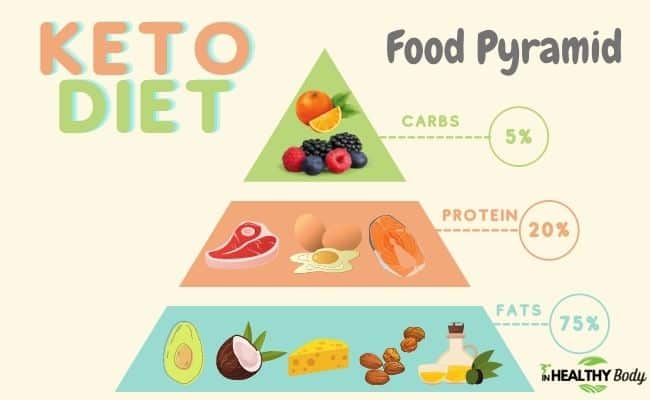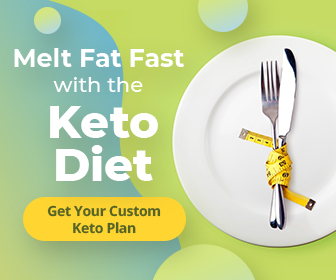The ketogenic diet or keto diet, as we commonly refer to, is a low-carb, high-fat diet that offers significant health and weight loss benefits.
In recent years, more people, especially those over 40, are following the ketogenic diet to lose weight and improve their health. (1)
Numerous studies show that this diet can help us lose weight, boost metabolism, fight diseases, and improve general health. (2)
Advertisement
Ketogenic diets may even have benefits against prediabetes, diabetes, metabolic syndrome, cancer, brain injuries, epilepsy, Parkinson’s disease, and Alzheimer’s disease.
What Keto diet is
The keto diet is a diet high in fat and low in carbohydrates.
Nowadays, it has become extremely popular, but compared to others, it is recognized as a difficult diet to start.
The biggest difficulty in the Keto diet is that modern people’s daily diet contains mostly carbohydrates.
By following this diet, our body slowly burns fat instead of carbohydrates, leading to weight loss, better health, and, as many experts believe, better control for patients with diabetes. (3)
It is impressive that medicine uses a Keto diet to treat epilepsy in children when epilepsy gets resistant to drugs. (4)
The help of this diet is important because it forces the body to burn fat rather than carbohydrates.
The basic idea about this diet is that when one burns calories from carbohydrates, the body will burn fat for energy, going into a state called ketosis. (5)
Ketones, therefore, become the main source of energy for our bodies and nourish the heart, kidneys, and other muscles.
The body also uses ketones as an alternative source of energy for the brain. (6)
Due to the action of ketones, it got its name from this famous dietary pattern.
The role of healthy fats in our diet
Many people fear fats because they have learned that they are harmful to our bodies.
Sometimes, they are.
Especially, the poor-quality fats included in many snacks and junk foods.
And yet, we do now know that fat is an essential component of our diet, and that everything is a matter of choice.
You may not even know that our brain comprises about 60% of fat, and half of this fat is by omega-3 fatty acids.
Click below to claim your 100%-made-for-you keto meal plan designed to help you lose fat, boost energy levels, and improve health. They will show you what to eat every day to reach your goals in the fastest and most enjoyable way.
Get A Complete 8-Week Ketogenic Diet Plan With Guidance Below:
Our brain uses them to create brain and nerve cells, which are essential for learning and memory. (7)
Omega-3s can also slow down age-related mental decline. (8)
They help prevent Alzheimer’s disease, while not getting enough omega-3 is associated with learning disabilities, but also with depression. (9)
How Keto diet works in our bodies
A reduced carbohydrate intake characterizes the ketogenic diet.
The total number of carbohydrates in a ketogenic diet rarely exceeds fifty grams per day.
The largest percentage of energy intake in a ketogenic diet is covered by fat intake (70-80% of total daily calories). A smaller percentage comes from protein intake (15-20% of total daily calories), while carbohydrate intake occupies only 5-20% of total daily calories.
For a diet with 2000 calories, this translates to about 165 grams of fat, 40 grams of carbohydrates, and 75 grams of protein.

How do we ensure that we consume the recommended ratio of macronutrients in a Ketogenic diet?
Since this diet is low in carbohydrates, the foods allowed to be consumed are rich in fat (monounsaturated, polyunsaturated, and saturated fats) and protein.
The main foods found in a ketogenic diet are meat, eggs, cold cuts, cheeses, fish, nuts, vegetable oils, butter, seeds, and non-starchy vegetables (e.g., green leafy vegetables, broccoli, cauliflower, brussels sprouts, onions, mushrooms, cucumber, celery).
Fruits with low carbohydrate content such as berries may be consumed in small quantities.
Such foods as below are recommended to be avoided due to their high carbohydrate content:
- Cereals (e.g., bread, rice, pasta)
- legumes (e.g., beans, lentils)
- fruits and fruit juices
- starchy vegetables (e.g., potatoes, corn, pumpkin)
Below is a list of foods commonly found in a ketogenic diet, without implying that everything is beneficial to our health.
Therefore, we need to pay attention to both our individual choices and their frequency of consumption:
- Meat: red meat such as beef and pork, poultry such as chicken and turkey, cold cuts such as ham, sausage, and bacon
- Fatty fish like salmon, trout, sardines, tuna
- Eggs
- Dairy products such as milk, cheese, yogurt, butter, cream
- Nuts and seeds like almonds, walnuts, flaxseed, pumpkin seeds, tahini, peanut butter
- Fats and oils such as extra virgin olive oil, sunflower oil, avocado oil, linseed oil, rapeseed oil, olives
- Avocado slices or whole avocado, or fresh guacamole
- Fruits and vegetables with low carbohydrate content such as green vegetables, tomatoes, onions, peppers, strawberries, berries
How Keto diet works for weight loss
According to the findings of several studies in obese adults, the ketogenic diet can contribute to weight loss, lowering bad cholesterol, and increasing good cholesterol. (10)
Applying the ketogenic diet in the effort to lose weight seems highly effective in the short term.
Several of the possible mechanisms that contribute to weight loss are the reduction of appetite, through the anorexic action of ketones. (11)
Additionally, weight loss accelerates the high saturation index of fat and proteins, the thermogenic effect of protein, and the increased energy cost of glucose production from non-carbohydrate sources.

There is also evidence that applying the keto diet in the short term is associated with improved lipid profile, insulin resistance, blood pressure, and better glycemic control in people with type 2 diabetes. (12)
Keto diet for weight loss may benefit as:
- It decreased appetite as protein is more filling while appetite control hormones change, and ketone bodies suppress appetite.
- By reduction of lipogenesis (fat formation) and increased lipolysis (fat distribution).
- Metabolism becomes more efficient in burning fat.
- More calories are used by the body than the use of fat and protein as energy.
How Keto diet differs from a normal diet
The ketogenic diet became popular for weight loss due to the high popularity of low-carb diets.
The well-known Atkins diet was the first of these, followed by other high-protein and low-fat diets such as Paleo, South Beach, and Dukan.
The amount of protein in the ketogenic diet is moderate compared to other low-carb diets, as consuming a large amount of protein can prevent ketosis.
Moderate protein intake is also important for maintaining muscle mass.
Keto diet Quiz
You can follow the quiz below and answer the questions about your diet and weight loss needs:
Advertisement
Ketogenic diet example
Several scientific studies have concluded that a diet low in carbohydrates but high in fat may be more effective in losing weight than a low-fat diet. (13)
A classic ketogenic diet program consists of 80% fat, 15% protein, and only 5% carbohydrates.
Someone who will consume 1,500 calories a day will only eat nineteen grams of carbohydrates.
To prepare a diet high in fat, which will logically be difficult at first, we need to make minor changes and have a plan.
For example, the Keto diet is forbid bread in a burger; however, we can use lettuce leaves. Or, instead of French fries, we can use green vegetables.
Another example is that we must cook with more oil, and especially olive oil.
The key is to start slowly but steadily, removing carbohydrates and replacing them with fats.
The Keto diet has some limitations:
Due to the very low percentage of carbohydrates, it allows those who follow it to eat mainly meat, whole dairy products, and starch-free vegetables, such as greens.
Vegetables such as cabbage, cauliflower, and potatoes should be avoided, and all cereals and most fruits.
Just one apple has more than the average daily dose of carbohydrates that one should eat.
Ketogenic diet benefits
The Keto diet has been linked to reduced appetite, faster weight loss, and activates a better bowel function. It is often thought to help with skin conditions and concentration. (14)
Low-carb diets can increase the basal metabolic rate compared to high-carb diets.
In recent studies, there appears to be a metabolic advantage of about 200-300 more calories burned, compared to a high-carbohydrate isothermal diet. (15)
In a large-scale study, they compare a ketogenic diet and a low-fat diet. The study focused on long-term weight loss and the risks of cardiovascular disease. (16)
The results showed that people on a ketogenic diet had reduced body weight and triglycerides, and it had decreased diastolic blood pressure.

The people in the study had also elevated HDL and LDL cholesterol levels.
Finally, it was found that people on a ketogenic diet lost more weight overall than people on a low-fat diet.
According to studies, the Keto diet can be beneficial for a wide range of health conditions:
• Heart disease: help improve risk factors like body fat, HDL cholesterol levels, and blood pressure (17)
• Epilepsy: the ketogenic diet can reduce seizures in epileptic children (18)
• Cancer: Keto diet may help slow tumor growth and can be an additional treatment for cancer (19)
• Polycystic ovary syndrome: it can help reduce insulin levels (20)
• Alzheimer’s disease: it may help reduce its symptoms and slow its progression (21)
• Parkinson’s disease: one study found that the Ketogenic diet helped improve the symptoms (22)
• Brain injuries: the diet could improve outcomes of traumatic brain injuries (23)
Keto diet basic steps
To try a ketogenic diet, you should:
• Eliminate carbs by checking food labels
• Prefer foods like meat, nuts, cheese, avocados, whole eggs, healthy oils, and oily fishes
• Fill your plate with veggies which provide fiber intake
• Track your progress and watch your weight every 3 to 4 weeks
• Follow a plan because as with any diet, it is crucial to have a plan for meals, drinks, or snacks
• Drink enough water and herbal teas and get proper amounts of electrolytes like sodium, potassium, and magnesium
• The ketogenic diet increases diuresis, and you lose salts, so add enough sea salt to your meals. If you do not replace it, you will feel fatigued, weak, may have headaches, and lethargy
• If you are hungry between meals, you can consume one teaspoon coconut oil or pure butter, with a little cocoa and stevia or plain
Practically, you add only 20 gr. carbohydrates per week, and you notice changes in your weight.
For example, you may consume: a small portion of fruits, or one slice of bread, or 1/2 cup cooked legumes, pasta, or peas, or 2 full tablespoons of oats, or cooked rice, or a small potato.
The secret behind the ketogenic diet is that it takes advantage of the body’s normal mechanism to use fat as fuel.
7-day Ketogenic diet meal plan
Day 1
• Breakfast: 2 chia and flaxseed toasts with 4 slices of mortadella.
• Lunch: Salad with 100 gr. canned sardines in olive oil, 2 tbsp. raw green vegetables (lettuce, baby spinach, arugula, valerian), 1/2 avocado with 1 tbsp. olive oil and 1 tbsp. apple cider vinegar.
• Dinner: 125 gr. chicken leg cooked with 2/3 cup roasted zucchini, and 1 tbsp. olive oil.
• Dessert: Jelly with sucralose sweetener served with 1 tbsp. whipped cream with 35% fat.
Day 2
• Breakfast: 2-3 egg muffins cheese, bacon, or 2 boiled eggs with 2 slices of mortadella.
• Lunch: Salad with 100 gr. roasted chicken leg, 2 tbsp. raw green vegetables (lettuce, baby spinach, arugula, valerian), 1/2 avocado with 1 tbsp. olive oil, and 1 tbsp. apple cider vinegar.
• Dinner: 125 gr. sardines or anchovies baked in the oven with oregano and 1 tbsp. olive oil with 2/3 cup. greens sautéed with 1 tbsp. olive oil.
• Dessert: Jelly with sucralose sweetener served with 1 tbsp. whipped cream with 35% fat.
Day 3
• Breakfast: 2 tbsp. chia seeds and linseed breadcrumbs with 4 slices of mortadella.
• Lunch: Salad with 100 gr. canned sardines in olive oil, 2 tbsp. raw green vegetables (lettuce, baby spinach, arugula, valerian), 1/2 avocado with 1 tbsp. olive oil, and 1 tbsp. apple cider vinegar.
• Dinner: 100 gr. beef liver with 2/3 cup grilled mushrooms sautéed with 1 tbsp. butter.
• Dessert: Jelly with sucralose sweetener served with 1 tbsp. whipped cream with 35% fat.
Day 4
• Breakfast: Toast with flaxseed bread cut in half with 2 slices of mortadella.
• Lunch: Salad with 100 gr. ready smoked trout, 2 tbsp. raw green vegetables (lettuce, baby spinach, arugula, valerian), 1/2 avocado with 1 tbsp. olive oil, and 1 tbsp. apple cider vinegar.
• Dinner: Omelet (3 eggs) with 1/3 cup spinach and 1/3 cup mushrooms, all cooked with 1 tbsp. butter.
• Dessert: Jelly with sucralose sweetener served with 1 tbsp. whipped cream with 35% fat.
Day 5
• Breakfast: 2-3 eggs, muffins cheese, and bacon, or 2 boiled eggs with 2 slices of mortadella.
• Lunch: Toast with flaxseed bread cut in half with 2 slices of mortadella and 2 lettuce leaves.
• Dinner: 125 gr. minced meat burger only (not lean). Just salt the outside of the burger to make it juicy. Bake on high heat in a pan or grill. Accompanied by 2/3 cup boiled broccoli, or zucchini, or greens with olive oil and apple cider vinegar.
• Dessert: Jelly with sucralose sweetener served with 1 tbsp. whipped cream with 35% fat.
Day 6
• Breakfast: 2 chia and linseed breadcrumbs with 4 slices of mortadella.
• Lunch: Toast with seals-flaxseed bread cut in half with 2 slices of mortadella and 2 lettuce leaves.
• Dinner: 2 straws of chicken leg with 2 cups (0.47 liters) raw green vegetables (lettuce, baby spinach, arugula, valerian), 1/2 avocado with 1 tbsp. olive oil, and 1 tbsp. apple cider vinegar.
• Dessert: Jelly with sucralose sweetener served with 1 tbsp. whipped cream with 35% fat.
Day 7
• Breakfast: Omelet (2 eggs) with 2 slices of bacon.
• Lunch: Milk lamb leg cooked in oil paste with 2 cups (0.47 liters) raw green vegetables (lettuce, baby spinach, arugula, valerian), 1/2 avocado with 1 tbsp. olive oil, and 1 tbsp. apple cider vinegar.
• Dinner: 125 gr. sardines or anchovies baked in the oven with oregano, and 1 tbsp. olive oil with 2/3 cup. greens sautéed with 1 tbsp. olive oil.
• Dessert: Jelly with sucralose sweetener served with 1 tbsp. whipped cream with 35% fat.
To Get A Complete 8-Week Ketogenic Diet Plan With Guidance, Check The Program Below:
Is the Keto diet for vegetarians?
There are many choices available in vegetable proteins such as mushrooms and legumes.
The modified ketogenic diet for vegetarians, allows the increase in carbohydrates to 20% of the daily caloric intake, with the protein being 20-40% and the fat 40-60%.
Some programs and plans help you follow the Keto diet according to your own dietary choices, such as the above program.
When to stop the Keto diet
There are some studies showed that participants did not lose more weight than those on a non-ketogenic diet. (24)
They were in a bad mood and had higher levels of inflammation in the body, which were linked to various conditions, such as heart disease and cancer. (25)
Some of the short-term symptoms that can be caused by such a diet are headaches, fatigue, nausea, bad breath, and dizziness. (26)
To be sure that you are getting the vitamins and trace elements that your body needs, it is best to follow the diet after consulting a nutritionist or a detailed diet plan.
What is certain is that the adoption of any restrictive diet for a long time poses risks to both health and the maintenance of weight loss eventually.
Because the vegetarian diet is restrictive, it may not be an excellent choice for everyone.
Children and women who are pregnant or breastfeeding should avoid it, as it can restrict several nutrients vital to proper growth and development.
It may also not be suitable for athletes, people with a history of eating disorders, or people with type 1 diabetes.
If you have an underlying health condition or are taking medication, talk to your doctor before starting the Keto diet or any diet.
People who should NOT do a ketogenic diet are:
People with:
• Renal failure
• Elevated liver enzymes
• Kidney stones
• History of pancreatitis
• Congenital abnormality in fat β-oxidation
• Congenital carnitine deficiency
• Porphyria
The Ketogenic diet – how to start
You can start a ketogenic diet plan by yourself.
However, following a complete diet plan will help you get the best results for weight loss and overall health.
You can try an 8-week Ketogenic diet plan below:
Advertisement

I wish you all the best and have a wonderful day!


